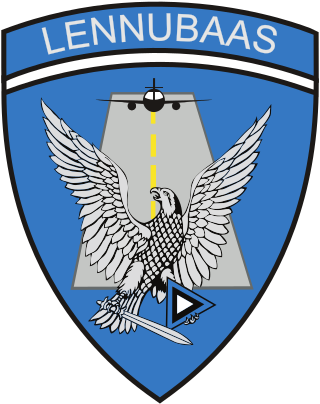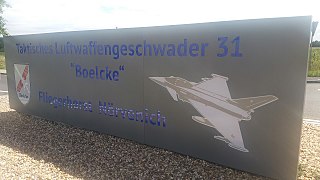
The German Air Force is the aerial warfare branch of the Bundeswehr, the armed forces of Germany. The German Air Force was founded in 1956 during the era of the Cold War as the aerial warfare branch of the armed forces of West Germany. After the reunification of West and East Germany in 1990, it integrated parts of the air force of the former German Democratic Republic, which itself had been founded in 1956 as part of the National People's Army. There is no organizational continuity between the current German Air Force and the former Luftwaffe of the Wehrmacht founded in 1935, which was completely disbanded in 1945/46 after World War II. The term Luftwaffe that is used for both the historic and the current German air force is the German-language generic designation of any air force.

Zweibrücken Air Base was a NATO military air base in West Germany. It was located 35 miles (56 km) SSW of Kaiserslautern and 2 miles (3.2 km) SE of Zweibrücken. It was assigned to the Royal Canadian Air Force (RCAF) and the United States Air Forces in Europe (USAFE) during its operational lifetime. It was a constituent member of the Kaiserslautern Military Community.

The Baltic air-policing mission is a NATO air defence Quick Reaction Alert (QRA) in order to guard the airspace above the three Baltic countries of Estonia, Latvia and Lithuania.

Taktisches Luftwaffengeschwader 74, formerly known as Jagdgeschwader 74 , is an aviation unit of the German Air Force, based on Neuburg Air Base in Bavaria since 1961. On 1 October 2013, the unit was renamed in the course of adaptations to the new structure of the German Air Force.

Ämari Air Base is a military airbase in Harjumaa, Estonia, located 7 km (4.3 mi) south of Lake Klooga and 20 nautical miles southwest of Tallinn.
Taktisches Luftwaffengeschwader 73 "Steinhoff", formerly known as Jagdgeschwader 73, is a fighter wing of the German Air Force. The wing is based in north-eastern Germany at Rostock-Laage Airport near Rostock. Its role includes general air defence as well as training for the Eurofighter Typhoon.

The 86th Air Division is a former designation of the 86th Airlift Wing, a United States Air Force organization. It was assigned to United States Air Forces in Europe at Ramstein Air Base, West Germany. It was inactivated on 14 November 1968. Its mission was the air defense of NATO-controlled airspace in Western Europe.

Taktisches Luftwaffengeschwader 51 "Immelmann", formerly known as Aufklärungsgeschwader 51, is a tactical reconnaissance wing of the German Air Force.

The 20th Fighter Squadron is an inactive United States Air Force (USAF) squadron. It was most recently part of the 49th Fighter Wing at Holloman Air Force Base, New Mexico, where it operated the McDonnell F-4 Phantom II aircraft, conducting training and air superiority missions. It was inactivated on 20 December 2004.

Quick Reaction Alert (QRA) is state of readiness and modus operandi of air defence maintained at all hours of the day by NATO air forces. The United States usually refers to Quick Reaction Alert as 'Airspace Control Alert'.

Icelandic Air Policing is a NATO operation conducted to patrol Iceland's airspace. As Iceland does not have an air force, in 2006 it requested that its NATO allies periodically deploy fighter aircraft to Keflavik Air Base to provide protection of its airspace. The first deployment of aircraft took place in May 2008.
Rheine-Hopsten Air Base is a former German Air Force military airfield, located 9.3 km north east of Rheine in Westphalia, Germany. The runway was closed in 2005 with the retirement of the F-4F Phantom II aircraft.

Nörvenich Air Base is a German Air Force air base in Nörvenich, North Rhine-Westphalia, Germany . It has been the home of Taktisches Luftwaffengeschwader 31 "Boelcke", which flies the Eurofighter Typhoon. Since 2023, Tactical Air Force Wing 33 from Büchel Air Base, the sole remaining German base with nuclear weapons, has been exercising at Nörvenich Air Base, while Büchel´s airfield will be renovated to accommodate for the new F 35 jets by 2026.

Taktisches Luftwaffengeschwader 31 "Boelcke", formerly known as Jagdbombergeschwader 31, is a fighter-bomber wing of the German Air Force (Luftwaffe). The wing is based in west Germany at Nörvenich Air Base. Its role are Air Interdiction, Offensive Counter Air and Close Air Support. The wing flies the Eurofighter Typhoon.

Taktisches Luftwaffengeschwader 33, formerly known as Jagdbombergeschwader 33 is a fighter-bomber wing of the German Air Force (Luftwaffe). The wing is based in west Germany at Büchel Air Base. Its role are Air Interdiction, Offensive Counter Air and Close Air Support. The wing flies the Panavia Tornado IDS.

Wittmundhafen Air Base is a military air base in Germany. It is home to Tactical Air Force Wing 71 of the German Air Force (Luftwaffe). Since May 1974 the F-4F Phantom II was operated from the base. German F-4F Phantoms at the base were retired on 29 June 2013. During 2013, the squadron transitioned to the Eurofighter Typhoon. Prior to May 1974, the base was home to the F-104G Starfighter. Up to the mid/late-1980s the wing operated a handful of Dornier Do 28D. The base currently stores all former F-4F Phantoms of the German Air Force.

Ingo Gerhartz is a German Air Force lieutenant general. He has been serving as the Inspector of the Air Force since 2018.
No. 135 Expeditionary Air Wing previously No. 135 Wing is a wing of the Royal Air Force. It was stationed at RAF Leeming, controlling the deployable subunits of the base. It was activated on 1 April 2006 as part of a modernisation package to make the RAF more deployable on an expeditionary basis.
No. 121 Expeditionary Air Wing is a deployable Expeditionary Air Wing of the Royal Air Force based at RAF Coningsby, Lincolnshire, England, UK.



















